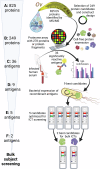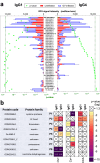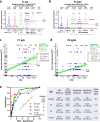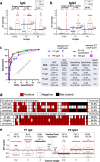Immunomics-guided biomarker discovery for human liver fluke infection and infection-associated cholangiocarcinoma
- PMID: 40595543
- PMCID: PMC12218120
- DOI: 10.1038/s41467-025-61043-2
Immunomics-guided biomarker discovery for human liver fluke infection and infection-associated cholangiocarcinoma
Abstract
Sensitive diagnostics are needed to improve management and surveillance of opisthorchiasis and opisthorchiasis-associated cholangiocarcinoma (CCA) throughout East Asia. Herein we generate and screen an Opisthorchis viverrini recombinant secreted proteome to identity antibody biomarkers of liver fluke infection and CCA with sera from study participants in endemic populations and evaluate their utility as point-of-care immunochromatographic tests (PoC-ICTs). We incorporate two of the most promising antigens from the proteome array screen, P1 and P9, into PoC-ICTs to further validate their diagnostic performance. The P9-IgG4 PoC-ICT is superior amongst the single recombinant antigen tests for diagnosing fluke infection as well as fluke-induced CCA, and out-performs parasite crude extract-IgG ICTs. Here we identify two biomarkers of O. viverrini infection and infection-associated CCA that could form the basis of novel antibody serodiagnostic tests for human liver fluke infection and associated cancer.
© 2025. The Author(s).
Conflict of interest statement
Competing interests: The authors declare no competing interests.
Figures





References
-
- Furst, T., Keiser, J. & Utzinger, J. Global burden of human food-borne trematodiasis: a systematic review and meta-analysis. Lancet Infect. Dis.12, 210–221 (2012). - PubMed
-
- Sithithaworn, P., Yongvanit, P., Duenngai, K., Kiatsopit, N. & Pairojkul, C. Roles of liver fluke infection as risk factor for cholangiocarcinoma. J. Hepatobiliary Pancreat. Sci.21, 301–308 (2014). - PubMed
MeSH terms
Substances
Grants and funding
LinkOut - more resources
Full Text Sources
Medical

